The field of copywriting now is significantly different from what it was 10 years ago. Copy Chief’s Kevin Rogers, however, has weathered the changes and stayed at the top of his game.
How can you ensure your copy is in line with the times and gets the sales and conversions you’re after? Kevin shares his best practices and insights in this value-packed interview.
Podcast: Download (Duration: 37:23 — 34.4MB)
Get Notified Of Future Episodes Apple Podcasts | Spotify | Amazon Music | Android | Blubrry | Gaana | TuneIn | Deezer | Anghami | RSS | More
In the episode:
01:42 – What’s got people so enthused about copy?
03:14 – When segmentation goes mainstream
04:25 – The two-way street that leads to a sale
05:54 – How case studies enter the conversation
07:57 – The argument for authenticity
14:24 – There’s just no tricking the platform
16:14 – The real difference between pros and wannabes
17:57 – It all boils down to dialogue
21:36 – Kevin’s amazing copy-generating machine
23:37 – Bot versus the human element
25:30 – What do you do with the feedback?
30:11 – I really enjoyed the episode… can I be on your show?
32:33 – Working the big copywriting theme
Keep up with the latest in marketing developments with James’ help
Transcription:
James: James Schramko here. Welcome back to SuperFastBusiness.com. This is Episode 713, and I’m chatting with my good friend, Kevin Rogers. Hey, Kevin.
Kevin: Hello, James. I got to tell you, I’ve listened to your podcast so much and for so long, I get that celebrity effect when I hear you do that intro. Do you what I mean? I feel like Wow, I’ve been on that show I love.
James: I’ve been listening to all my episodes, and I don’t get it at all. It’s just me.
Kevin: You’re special. You’re special to the world, my friend.
James: You’ve been pretty busy over there. I’ve seen you’ve been publishing your own podcast and putting extracts from Copy Chief Live. Of course you’re famous from having CopyChief.com.
And I don’t know if it’s just me, but lately, I’ve been picking up this huge theme of copywriting. It’s just everywhere; it’s become important for some reason. I think maybe people had some quick wins on social media, and now, as the market’s all sort of commoditized, the edge is having good copy and having good stories. And I’d love to see what you think, as a veteran copywriter. What’s your perception of what’s happening in the marketplace? Has there been any changes that you’ve observed over the last 10 years?
What’s got people so enthused about copy?
Kevin: Yeah, actually, in 10 years for sure. And I think even more so in the last year or two. I think the reason people are more excited about copy is it’s kind of redefined itself in our world of direct response. It used to be, there were very set ways to do things. And a lot of people were uncomfortable with the things that you supposedly had to do to sell with copy. And now because of social media, and the different types of conversation that we experience every day – think about it, James, every year it more and more becomes part of our lives, right? And we’re just used to communicating a certain way. Shorter. We communicate different ways in different platforms – you wouldn’t talk to me the same way in email necessarily as you would in a Facebook comment. And so, it’s more challenging in some ways, it’s more instinctive.
And so I think we’re more comfortable communicating in general, with words in text. And things that work better today are things we’re more naturally inclined to be good at, like sharing our stories, sharing parts of our lives, and getting to see it almost in real time, the kind of reactions those kinds of copy are getting as opposed to the old, more formal ways of writing copy.
James: I’m thinking of resources like the Gary Halbert letter. And he used to share stories about his personal life. He might have been well suited to social media, if he were marketing today.
Kevin: Oh, yeah. For sure
James: He would be really glued to what’s happening.
When segmentation goes mainstream
But I can think of a couple of things that might have changed in the last few years. One is segmentation. It’s definitely been more mainstream now, where you can have a much more targeted conversation from whether it starts with a quiz or a survey chooser. That’s like the basic type of segmentation where you’re sending people down the right path from the early stages. Or then there’s the other kind of segmentation, which you’ve seen on documentaries like The Great Hack, the way that politics is being run now, where they can run micro campaigns in different regions, where people in those regions are only seeing their experience of messaging, and it’s super hyper relevant for them, but it might be completely different to what someone on the other part of the exact same country is receiving.
So the segmentation is number one. It’s most definitely become more mainstream. I’m using segmentation because I want to have a relevant conversation with people at the right stage. Of course, we’ve got technology backing that up now. We can use behavioral email sequences, which again, it’s a lot more complicated in how it works, compared to five years ago or 10 years ago, not as many people using segmentation plus behavioral-based triggers.
The two-way street that leads to a sale
And then the other thing that I think’s different is, you know, when I started online, it was really just sales pages, where as a copywriter, you had to guess all the possible objections and you had to have the whole conversation in that one piece of dialogue. Whereas now with social media, and also Dean Jackson‘s method of the nine-word email, we’re now finding a lot of email’s conversational-based and a lot of social media, especially chatbots, and chatting, has become a two-way street. So now, you don’t have to cover the whole enchilada in one document. You can start the conversation, and then it can be responsive and dynamic based on what happens next. So I think that that’s the main change that I’ve observed in the last few years.
Kevin: Love that. That’s very accurate. And you know, things like, within those conversations, tools you can have. For instance, we, James, just sold out a coaching program, 50 seats at $1,000. And did it all through conversations. We did have the traditional things, a sales page and all that stuff, but primarily, those new members were welcomed aboard through an email conversation sequence. And what that allows you to do is two things. Number one, you’re constantly in dialogue, so you’re constantly getting updated research and better understanding of what people need, what their hesitations are, what their objections are. And so you can update the copy in real time.
How case studies enter the conversation
The other thing is, you had Brian McCarthy on recently who does the case studies, right?
James: Yeah.
Kevin: And so we have several case studies from Brian. And we can send in a link, a page to the most relevant case study we have, depending on that person’s situation. And so now, suddenly, because copy is much more of a conversation – than, like you said, it used to be completely one sided, take it or leave it – now, we can adjust and make use of our resources in ways that we never could before.
James: It’s really getting closer to what would happen in a real live, human-to-human sales conversation, and I’m casting my mind back to when I sold for living. Well, when my business card said Sales. Okay, I want to clarify that. We all sell, whether we know it or not. But when I was having those human conversations, of course, I would pull out the most relevant case study. We actually had, and we were trained on having, an evidence manual in the Mercedes-Benz dealership. And in that evidence manual was every piece of information or resource that would defend against all the other competitor models, that would show any awards our product had won, and any sort of research or science that came from the factory and crash test, etc. It was in our evidence manual, and we would leaf to the page that was most relevant.
I think when you’re having a messaging back and forth with a potential candidate for your program and you send them the exact case study that will help them place themselves in that scenario and see that they could be better off, and therefore in a great position to move forward, then that’s the perfect simulation of what would happen if you had the ability to sit down with each person over coffee at a table.
Kevin: Yeah, hundred percent. And the other thing we’ve seen is, when you approach even cold traffic ads, from that point of view of having a conversation, so for instance, opening the ad with a line of dialogue, that’s another way that we’ve seen be really effective. It helps with compliance issues; it helps with nurturing. And again, it’s the way people prefer to communicate, rather than being yelled at.
The argument for authenticity
James: So with that way that people like to communicate, we’re seeing a lot of banter. I’ve had an interesting relationship with social media. I’ve never wanted to engage people with those dumb posts, like what superhero would you be or whatever. Like, they’re clearly a manipulation to trigger algorithms. And I’ve always wondered, why can’t people see that and why don’t they hate the person that posts them, and say, like, you’re just using me as algorithm fodder. I haven’t understood it. The same as like, you know, post a word below this post to trigger my autobot. Where do you think the line is in authenticity for that? Or like, people in our market, are they just so hardened now and so exposed to it, they just don’t care, or they don’t know? What do you think?
Kevin: That’s interesting. I think it’s a little of both, I think it depends on the source, right? If I’m on Instagram, and I see James Schramko asking me a general question that doesn’t feel like it’s to lead me down a sales path, and I like James Schramko, and I’m going to hit that little button yes or no or something or get to type in my thoughts. I’ve seen my friend’s kids doing that on Instagram sometimes and I’m thinking, this is genius – they don’t even know they’re in a market. This is marketing, really, you know.
“What a kid in high school is doing on social media is authentic, and they’re using it the way that it probably is supposed to be used by normal humans, not manipulative marketer types.”
James: That would be the definition of authentic. I see my little niece posting those surveys. In fact, I’ll go so far as to say that she’s part of my R&D team. I follow my niece and I see what she’s doing. And what a kid in high school is doing on social media is authentic, and they’re using it the way that it probably is supposed to be used by normal humans, not manipulative marketer types.
Kevin: Right. Yeah. And what are they doing? They’re talking about their day, a lot about their feelings, how they feel. And I think the other thing we have to remember is, we forget this as business owners, as entrepreneurs, because we’re overwhelmed and we’re in conversation every day, like we’re having right now. We’ve got all these meetings booked. But most people are lonely, and they don’t have enough people in their life to talk to that they feel like, really understand them. And so when you ask somebody like that – again, especially if they like you and feel like they have something of a relationship with you – you ask them a question, they’re inclined to answer because they want to be in dialogue. It feels good.
James: Yeah, I asked people recently, what’s the best documentary they’ve ever watched. And I genuinely love documentaries. I watch lots of documentaries. It’s my favorite media consumption. I don’t even listen to podcasts, which surprises some of my podcast listeners. Documentaries I find really educational, and I’m fascinated by the art process of it as well. And I got a meltdown of responses. It was just like, wildly, it’s the kind of thing that people do to trigger the algorithm if they want to beef up their social sphere. But I guess I accidentally triggered the same result, but with an authentic question. I imagine, and I’ve seen actually off the back of that post, I’ve had some private conversations with some of the people who posted who, you know, have not connected for a while. And now we’re going to record some podcasts; we have some little private chats back and forth. Some people who I haven’t really had a good private chat to for five, six, seve, eight, nine years.
So it can be such a powerful medium for connection. And I think if you do it right – and I saw something today that I thought was really good I saw Gary Vee posted a live video and in the top right corner, it said pre-recorded. And I liked that. Because he’s not saying, I’m live right now. I’m not pretending to be live. This was recorded at a previous date, but I’m streaming it live. And he’s taking advantage of the fact it’s going to get shared a lot more because it notifies people that Gary Vee’s live. So he’s cleverly using the platform but in a way that has integrity compared to the way that some people use it.
“We want real stories and a more authentic approach.”
I think that’s the next wave for me, is how are people using social media. Is it trickery and fakery? Or is it clever and is it with integrity? I think that’s the next stage. I think we’re going to be harsher critics of how we’re being treated, in the same way that a screaming red-letter headline, no-player-control VSL (or video sales letter, for anyone who doesn’t know what that means) is almost offensive these days. You know, I just sat through one the other day, yesterday, to watch it. And this guy’s been doing the same thing for the last 10 years. Making these casual video sales letters with dog-ugly black and white slides, no player controls, and just jamming people to it like a puppy mill, just over and over and over. And I think the tolerance is going to wear out for that stuff, and I think we want real stories and a more authentic approach.
Kevin: Hundred percent. And guess who else wants that and demands that?
James: The customer.
Kevin: The platforms. You know, the platforms themselves.
James: Right. They’re pretty fussy aren’t they? They’re starting to block and ban and remove people who they feel are not playing the game that they want to play.
Kevin: Right. And so Facebook, for instance, is judging you on how people engage with your ad. If people are reporting your ad as, I don’t want to see any more of this – you know, I don’t know if you’re running as much cold traffic, James, but it’s been really interesting this year to look at people who will get angry at you for being in their newsfeed. And you want to say, Do you not understand how this works on Facebook? But you can’t just disregard that some people are ignorant to how Facebook makes money, that they’re showing you ads and Hey, sorry, you were targeted, but that’s the algorithm’s fault, not mine. And now you engaging with the ad is only making it happen more. So this is not helping, right? But the reality is, if people are reporting your ad is annoying, Facebook is seeing that and saying, you need to do a better job of communicating the way people communicate on this platform, not like an advertiser.
James: It’s one of the reasons I stopped running paid ads about five or six years ago. Well, two reasons. One is, the agency who was running them, all of their accounts got shut down. So my account got shut down along with everyone else’s for no particular reason. I think maybe it’s like the tax department when they find a bad accountant. They just go and order everyone the accountant’s been dealing with. I think some of the other people in that agency were doing bad things, and I got taken out.
But also I didn’t like the negative comments. I don’t want to log into Facebook and see people, you know, swearing in caps at my ad. And in hindsight, you know, maybe those ads were not as relevant as they could be. And I think the platforms are right to be fussy and to demand a good experience, because that’s the key to longevity. If they don’t, someone else will provide a better experience and they’ll be done.
There’s just no tricking the platform
And have a look how successful Google is with their search engine market share. You know, the whole SEO game has has been a tightly-held game from their point of view. They never published the rules; they have been vigilant at booting and de-indexing and penalizing manipulative websites, and they’ve got a pretty good result. I use Google a lot, actually, as a research tool. And we are, especially now with voice-controlled machines, accessing search engines all the time. So I think it’s good that they’re having a relevant platform, but it’s bad if you’re playing a short-term game or you’re trying to trick the platform. That’s a losing bet.
“You cannot outsmart Facebook.”
Kevin: Hundred percent. Yeah, you cannot outsmart Facebook. I was just at a mastermind with a lot of our mutual friends this weekend. Todd Brown, Todd Herman, and a lot of very smart marketers.
James: Basically, anyone called Todd.
Kevin: It was the Todd fest, really.
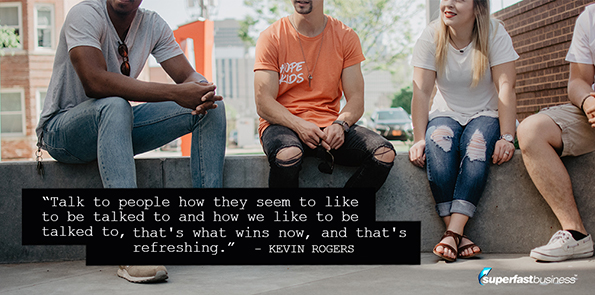 And that was the overriding theme, is that you’ll not out-trick them. For instance, the worst thing you can do is, if you have an ad banned, is to delete the ad and just put up a new ad, or people who think they can delete accounts and open new accounts under other emails and things. They are not going to risk the user experience, like you said, to be manipulated by some, you know, guys in basements. Unless you’re Russian, apparently. That still works. But you’ve got to know the rules and play by the rules, and it is very aggravating to have ads disapproved and not know exactly why. But if you learn to communicate on those platforms in a way that gets engagement and apply that to your ads, going back to what we said up top, why is copywriting more embraced and embraced in a new way than it was before? It’s for that reason. It’s like, we know what we like and if we just do that and talk to people how they seem to like to be talked to and how we like to be talked to, that’s what wins now, and that’s refreshing.
And that was the overriding theme, is that you’ll not out-trick them. For instance, the worst thing you can do is, if you have an ad banned, is to delete the ad and just put up a new ad, or people who think they can delete accounts and open new accounts under other emails and things. They are not going to risk the user experience, like you said, to be manipulated by some, you know, guys in basements. Unless you’re Russian, apparently. That still works. But you’ve got to know the rules and play by the rules, and it is very aggravating to have ads disapproved and not know exactly why. But if you learn to communicate on those platforms in a way that gets engagement and apply that to your ads, going back to what we said up top, why is copywriting more embraced and embraced in a new way than it was before? It’s for that reason. It’s like, we know what we like and if we just do that and talk to people how they seem to like to be talked to and how we like to be talked to, that’s what wins now, and that’s refreshing.
The real difference between pros and wannabes
James: Well, I think the big difference between having pro-level copy and not is the fundamentals. And you’re the expert on this, so please step in if I put a foot wrong here. But it really, the foundation of it is research.
Kevin: Yes.
James: Before you’re communicating anything, you have to get in there and understand everything about your prospect, about their pains, about their challenges, how they feel, all the things they’ve tried, where they’ve failed, what they’re thinking. And that’s the starting point before you communicate with them, right? So it gives you a better chance of being relevant and having a message that lands, which coincidentally can result in more sales.
So what I have seen lately, and we’re definitely doing this in my team, in the last team meeting we had, the whole team meeting was copywriting training. And you would have got a lot of material for your comedy routine hearing me teach my team copy. But the point is, you know, regular content publishing businesses are engaging copywriters for their emails, for their show notes. I’m getting approached by show note creators all the time these days. Their blog post titles. Obviously, their ads should be written with copy in mind. But their email sequences, like, every part of the business that goes public should have someone who’s trained in copywriting to attend to that, whether it’s internally or contracted externally.
I think that’s where you’ve probably seen changes with CopyChief.com, the type of people who use it. Because you’ve got two types of people who predominantly come in there, haven’t you? You’ve got the freelancer who wants to be a copywriter, and you’ve got the business owner who wants a copywriter. They’re the two main types.
It all boils down to dialogue
Kevin: Yeah. And what you said is, you’re preaching the word right here, dialogue. I always say that the most valuable thing you can have as a business owner, or a marketer of any kind, is a dialogue with your audience, because both parties need that as the first thing. So if you’re wanting to bring a copywriter into your life, and you say Well, how will I know if the copy is good? How do I know I’m hiring the right person, all these scary things. One thing you need to hand them is dialogue with your audience. And that is what I call, you know, copy porn to a copywriter. It’s, you know, if we can see exactly in the words of the prospect what they’re concerned about, what they’re hung up on, then we can solve the problems, right? We can turn every objection into a benefit-driven subhead throughout the copy and keep the conversation going and do all kinds of powerful things.
So, as a business owner, as a marketer, use social media, use surveys, any way you can get that deep dialogue with your audience. And of course, engage them back and forth and you and you can make sales that way, but keep a log of these things. So for instance, James, I mentioned the program we just sold out. All through email, so back and forth. So what I do after that is I take all that dialogue, and I put it into a single document. We had 25 pages of just their replies. And then I take that and I’ll like, put it into a word cloud to see what are the most common terms. Man, it’s so useful. It becomes, like, our Bible for that product. And again, this isn’t for manipulation. It’s for understanding.
You know, the old thing, James, in copy was, when it comes to your customer avatar, you should know them well enough so they can sit across from you and you could look them in the eye and you need to write the copy as if you’re talking just to then. Well, that’s, of course, still true. But the difference is, now you don’t have to guess or make that up in your head. It’s not a fantasy exercise. You can do it in real time every single day.
James: Right. I love the tag crowd tip. I picked that up from Ryan Levesque’s course where you take a whole bunch of data and stick it into this tool and it shows you what the common themes are. And the main point he was making when he taught that to me was that sometimes the audience use a particular word. A classic example is my old industry. In Australia, we use the word car, and in the USA, they use the word auto, you know? So same thing, but a different term – vastly different conversation you’re going to have.
Kevin: Right.
“The business owner is in a great position to be a good copywriter for their own business, because obviously they’ve had the most dialogue.”
James: I think one thing you’ve mentioned to me before is that the business owner is in a great position to be a good copywriter for their own business, because obviously they’ve had the most dialogue. They’re across it. Someone like me, I’m speaking to my clients every day in a forum. I attend local meetups every month. I travel around the world and meet people in their own home turf. I was over in St. Pete’s where you are, nearby, meeting your audience, like really understanding. And they draw out of the crowd. Like, Patrick in your audience, in my audience, you know, he came and approached me, came on our show, talked about video sales scripts.
Kevin: Yeah, he’s brilliant.
James: Go out to the front line and meet those people, you get the dialogue. So how can we take that golden dialogue information that we have as a business owner, and either use that directly or parlay that to our team? What’s a good technique?
Kevin: Yeah. Well, you can be technical about it. So you just want to gather that information and make it available. So one thing you could do, and you’re right, this really does, a lot of it comes from Ryan Levesque. I think Ryan really nailed it. The most powerful part of Ask for me as a copywriter was that deep-dive survey. And really reading through those responses.
Kevin’s amazing copy-generating machine
So one thing that’s more technical that we created was a way to take dialogue, pull out the the most common pain point phrases. And then we created a standard headline formula that would go at the top of any sales page, and show you how to put those keywords and phrases into the headline to where now you have a proven headline formula. And you’re speaking using the exact words of your customer. And then we can take that same thing and show you how to apply it to 50 different headline formulas. Right?
James: Right.
Kevin: So what’s interesting about this, and that’s a tool we have inside of Copy Chief.
James: Yeah, logging in with the team straight after this podcast.
Kevin: It’s awesome.
James: That’s exactly what we’re talking about. We record a podcast like this, we need to connect with our audience when we distribute that information. I literally just opened an email this morning that said, James, I love your content. I’m just not opening your emails. So I’m going to unsubscribe. And it’s like, Okay, well, thank you for letting me know. Hopefully you can pick up the feed on iTunes. But you know, if I had a better headline – you know, my question to myself is, what could I have done to assist these emails being opened? And we have a really good open rate as it is, you know? It’s already like, in the 20-something percentile, which I think is pretty good for a house list. And I’d love to connect more with my audience if they’re the right prospect. So I’m definitely going to go into Copy Chief and find that resource. What do you call it in there?
Kevin: I call it the survey copy generator.
James: Survey copy generator.
Kevin: So once you’ve done it, yeah, survey or collect… A more accurate title, we should update it to be the “dialogue-generated copy machine” or something, because it’s just about collecting that dialogue, and then what do you do with it? That’s it. People understand the concept of these conversations are valuable, but when you actually create a process for what to do with that, put it into a generator that spits out headlines for you, for instance.
Bot versus the human element
And you know, what’s interesting about this, James, is we keep hearing, this other question I get asked a lot these days is, well, what about these copywriting robots that IBM is creating and these other people are creating? And look, there’s some legitimacy to the idea that they could take, for instance, a process like I just described to you, and put it through that machine way faster than we ever could, right? But here’s the difference. The human element is what gets real dialogue from people. Again, the reason they open up, a person would send you a letter like that, most people would just unsubscribe, say, Get out of my inbox. I’m not reading this anymore. They thought enough of you to say, James, just want to let you know, I’m leaving the relationship.
“The human element is what gets real dialogue from people.”
James: Yeah. I imagine he’s sensitive and he would think that I’d look at my unsubscribes and be deeply hurt by someone leaving. Which, I do actually care. I do care about my subscribers and I am genuinely curious. Anytime someone leaves my coaching membership, I always ask them, How can I improve?
Kevin: Right. Same here. Yeah.
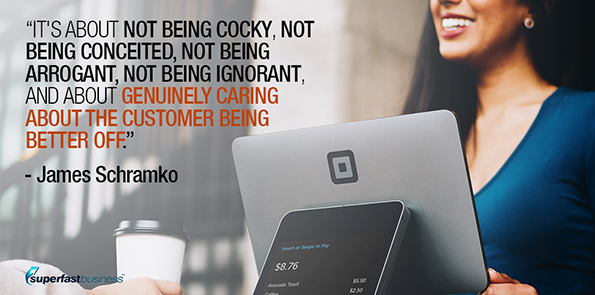 James: And I start the dialogue, because I want to make sure I close that hole in the bucket, if there’s something that is within my power to change it. And the reality is, quite a lot of time I can’t change, I can’t change that their family house burnt down or whatever, like that’s beyond my scope. And there’s a lot of that happening lately. But if it’s something I can change, I want to know. And it’s hard throwing yourself out there and being open to feedback, but it’s also the pathway forward. I think I probably resisted that a little bit earlier on, because you have to have this balance of unmesswithable confidence. Like, you have to be so confident when you start out to push through all the backward steps that are coming your way. But once you get there, it’s about not being cocky, not being conceited, not being arrogant, not being ignorant, and about genuinely caring about the customer being better off. If that was a core driver for most business owners, we’d have a great environment out there.
James: And I start the dialogue, because I want to make sure I close that hole in the bucket, if there’s something that is within my power to change it. And the reality is, quite a lot of time I can’t change, I can’t change that their family house burnt down or whatever, like that’s beyond my scope. And there’s a lot of that happening lately. But if it’s something I can change, I want to know. And it’s hard throwing yourself out there and being open to feedback, but it’s also the pathway forward. I think I probably resisted that a little bit earlier on, because you have to have this balance of unmesswithable confidence. Like, you have to be so confident when you start out to push through all the backward steps that are coming your way. But once you get there, it’s about not being cocky, not being conceited, not being arrogant, not being ignorant, and about genuinely caring about the customer being better off. If that was a core driver for most business owners, we’d have a great environment out there.
What do you do with the feedback?
Kevin: Right. Facebook would have no problem with what we’re doing. And you know, going back to those comments you said about taking the ads down and made you uncomfortable, I totally get that.
James: Yeah.
Kevin: But you know, what I’ve noticed after a while of doing this now, because those comments are actually really valuable. The good ones, you get a lot of good ones along with the trolls. And that really helps the value of an ad over time of course, right? To have that dialogue. So what I’ve done is some of them just need to be deleted. I literally have a guy now who’s spamming my ads with nonsensical words. It almost sounds like Muppet speak, they don’t even make sense. And he’ll spend 20 minutes just doing one after the other. I can’t imagine what his motivation is.
James: Maybe it’s a robot targeting your ads.
Kevin: It’s possible. You look at their profile, and who knows how real those things are. But other times people will make a sarcastic comment. For instance, one of the things in my ad says, you know, I’m a copywriter who’s helped my clients earn over 100 million dollars with my copy, and people love to go, That’s ridiculous. If you had 100 million dollars, why are you selling an $8 ebook, you idiot?
James: I saw that ad.
Kevin: It’s a heckle, right? And I say as a comedian, I say, I’ll make a video and I’ll explain. I’ll say, That’s a really great question and I can see where you’d find that odd. Let me explain to you how business works. I did not collect 100 million dollars or no, you would not be seeing me in this. But you know, I want to grow a business. Just kindly sort of explain it to them and have fun. Sort of that jujitsu judo “Yes, and…” improv idea.
And I’ve had more people like those videos when I call people out or explain it to them. It shows that there’s a whole other audience that are seeing that they might have had the same question and go, I wouldn’t have been as much as in an a-hole as this other person to call it out and be mean about it. But I was curious how you were saying that.
So, again, there’s always advantages in the dialogue. If you don’t take yourself too seriously, if you try to get to the core of, why is this person upset, or, why would they find that offensive? Maybe they’re jealous; maybe they’ve struggled; maybe they’re… And again, be human. That’s what the computers can’t do. They can’t generate that kind of dialogue because they can’t fake human-to-human interaction. And so yes, they’ll be faster, but we’ll always be better because so far, we’re still human.
James: Right. You know, that’s great feedback about the comments. One of my most-shared LinkedIn videos was about an unfavorite phrase of mine, where people want to pick your brain. And you know, I made a video about how it’s not a great phrase, and I gave a few ways to get out of that. And someone posted, you know, I’m really disheartened to see this; business is about meeting with people and interchanging and interacting. And I’m like, Hey look, don’t be upset about it. Like, if you like doing interactions, and the phrase “I want to pick your brain,” doesn’t upset you, then go for it. I’m not stepping in way of your enjoyment. I’m just at that point where I’ve had one too many people ask if they could pick my brain. If they approach me differently, I’ll catch up with them.
I met a friend of mine in a local coffee shop the other day, which is very rare. However, his approach was unquestionably excellent. And it was polite, it was value-driven, it was appealing. After the meeting, this is what he did, he’s very kind – he actually talked about it in the next email broadcast that he put out to his entire database. So it was an unexpected sort of hat tip, which was nice. But when they’re done with the right intention, it’s good. But the comment let me realize, hang on. I might not have explained what I’m trying to explain as well as possible. I was really having a go at the approach, not the concept of face-to-face. I mean, I get away from my desk more than most online marketers, actually. I do travel around; I do go to meetups; I do meet people all the time. I just don’t like that particular phrase – I think it could be much more elegantly put.
Kevin: Yes.
James: And, you know, led with value, not a take.
Kevin: It sounds offensive, not like anything anybody would want done to them.
James: The metaphor is ghastly.
Kevin: Pick your brain.
James: It’s like a scene from a movie where they open up your head and get in there with a knife and fork.
Kevin: Yeah. Why would you want anything picked, right? A scab, a nose… like, nothing you pick ends up being enjoyable. Don’t pick at that!
James: No good comes from it.
Kevin: It’s something we all grew up doing. Don’t pick at that!
But you know, quickly going back to that experience with your colleague locally there, I bet the other person, the thing that that person did that won you over was showed that they were paying attention to what you do, and some of this stuff. Like, they’re plugged into your materials, my guess.
I really enjoyed the episode…can I be on your show?
And I know you get this a lot, like I do, James, people requesting to be on your podcast, right?
James: Oh god, we get 10 a day. And it’s actually, someone’s got a template out there that sucks and it’s like, I really enjoyed the episode with you and Kevin where you were talking about copywriting. We do copywriting in our business, and you know, my boss blah blah blah asked if I could get in touch with you. He’d love to come on your show and share bullet, bullet, bullet, bullet, bullet. Let us know if you’d like to schedule it. Pretty much that’s the template.
Kevin: Right, exactly. So we both get tons of those. And it’s a quick delete, because we don’t want to have a cookie cutter conversation. We don’t want to bring on a person we’ve never met who’s there to pitch their agenda and give canned answers.
James: This is not a soapbox. You know, I’ve got interviews scheduled for quite some time, and they’re very organic. Like, this interview came about from you and I having a regular call; we meet every couple of weeks, chat about business. And the stuff you’re talking to me about, what you’re doing in your business and what I’m doing in my business, it came together as a symphony of some sorts. And I said, Kevin, we should share this information with my audience. Because it’s critical. Like, I’m seeing that’s probably the biggest change. And I haven’t published what we did in 2019 brag post this year. It was actually too good a year, and I just wanted to keep it to myself.
No, seriously. Like, it seems like everyone’s had a bad year last year for some reason, except for you and everyone I coach.
Kevin: I started seeing that too. I didn’t quite understand why people feel that way.
James: I didn’t understand why, either. I just had an absolutely stellar, stellar year on every front.
Anyway, copywriting is a big thing for us. I’m reengaging in Copy Chief. I came to your event. I loved your event. It was a fantastic event. It’s a strong recommend for me. It’s actually the only event I went to in the USA in 2019, and it was well worth the gargantuan effort. Gargantuan, gigantuan? Take your pick.
Kevin: Something fantuan.
James: Yeah, you’re the copywriter. Someone will look that up and tell me. Put a comment and I’ll take the feedback.
Kevin: And then they’ll tell you why they should be in your podcast and clarify it for you.
James: Yeah. “I love that episode with you and Kevin where you were talking about gargantuan.”
Kevin: “It actually comes from the root word…”
James: At least we know they’re listening. They’ve listened to a whole 37 minutes, so…
Kevin: But thank you for that.
Working the big copywriting theme
James: Yeah. It’s a big theme. It’s a big theme in 2020 for us, is to get our message right, because we want to be more relevant; we want to have appeal. So I’m having the team in discussion with this on an ongoing basis, I noticed the very first publishing opportunity that came straight after our meeting was our internal weekly newsletter. And we did a training last week, and in the next weekly newsletter that comes through our members (we send one each week, which is a big retention tip for anyone who has a subscription business) and instead of just saying, oh, if you miss the training, it’s here. Now they’re like, oh, last week, we did training on the topic, and they put the headline of thing and they said in the training, we did bullet, bullet, bullet, bullet, bullet, bullet, you know, and then it’s like, you can go and get the copy here. So they really sold it. And I think that would help someone who’s on the newsletter, who is a member and paying for membership, but didn’t attend the training. It would actually engage them in wanting to come and attend that training replay, because it was a really valuable training. But they sold it better.
We’ve been sitting on assets. We’ve been sitting on data and dialogue. Like most business owners, we’ve been guilty of collecting all this information, but not parlaying it in the best possible way out to the marketplace.
Kevin: That’s right. That’s good. Yeah.I love it.
James: That’s what we’re picking up, with your help as well, and your inspiration and some of these tools that you have.
Kevin: Yeah. Clarity, and again, knowing what they care about, what’s going to resonate with them. So you have your agenda for a great piece of content. But you and I have the advantage of running communities, forums, very active where people are telling us what they took from it, and it can be very eye-opening sometimes.
James: We could generate so much stuff. I mean, we publish a couple of podcasts a week – most people would kill for that amount of stuff. And you know, we publish it and then move on to the next one. So, the last time I did a podcast, well, I noticed one would come out that I’d already pre-recorded, I hopped onto my phone, and I talked about the podcast that we’ve just published and why you’d want to watch it, and I put it on my social media. So just being a little more aware of how we can let people know about what we’ve got is the theme for us, because we’ve got all the assets we need to have a business that’s performing at twice the size we’re performing. And all we have to do is just explain it better.
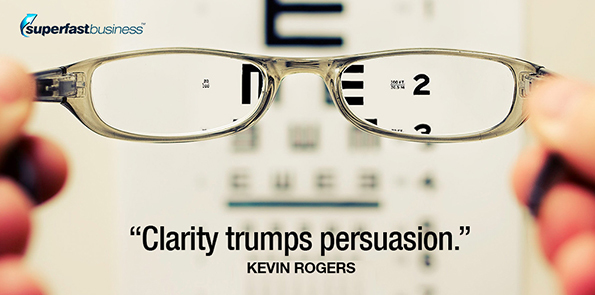 Kevin: That’s a great point. Clarity is king. That’s another great copy tip we can leave everyone with, is that clarity trumps conversion. Always. Or I should say, a better way to say it is, clarity trumps persuasion. I guess conversion still matters.
Kevin: That’s a great point. Clarity is king. That’s another great copy tip we can leave everyone with, is that clarity trumps conversion. Always. Or I should say, a better way to say it is, clarity trumps persuasion. I guess conversion still matters.
James: Is there a way to say it without using the word “trump” anywhere in that sentence?
Kevin: I wish there was. “Is more important than…” you’d just have to add so many words, but I know. That word is soured for eternity.
James: “Beats”?
Kevin: Card games are ruined. So many card games are ruined.
James: Kevin, thank you for sharing with us. And as always, you’ve been a repeat guest on SuperFastBusiness. There’s a whole archive of your previous episodes way back, like way, way back. You know, when you were a conversion king, I think back then. This is like, pre Copy Chief. I think you probably pitched me on coming on my podcast back then.
Kevin: Yeah.
James: You were like, we were barely friends.
Kevin: That’s awesome. That’s exciting.
James: We’ve become fantastic friends now. And I think the field you’re in is just getting stronger. The other thing that I firmly believe in, I’ve been making recommendations for anyone who asks, I think you’ll get a return on investment with Copy Chief membership. Because if you can tune your own copy as the business owner, perfect. If you feel stretched or it’s not your thing or whatever, then you’ve got a bevy of copywriters at your fingertips to help out and to critique things; frameworks you can give your team; you’ve got contractors of various types doing everything from video sales letters through to social media ads. And you’ve got a lot of the King Kongs in our online marketing industry in there, sourcing. You know, that’s their feeding trough, so to speak, of supply.
Kevin: Yeah, yeah. Hiring writers and contributing, too. People like Dean Jackson and Parris lampropoulos, Marcella Allison, Laura Belgray, who will be our special trainer, guest trainer in January. People that I’m a fan of, a huge fan of, and I get to jam with them, you know, dig into what they’re doing in their process. It’s been a thrill for me. I consider myself like, I’m the Dave Grohl of copywriting. You know, where I want to come and rock the crowd, but I love jamming with my heroes even more, you know, it’s just a thrill. And, man, you know, I’m having a blast, dude.
James: Thank you so much.
Well, if you’ve enjoyed this episode, head over to SuperFastBusiness. It’s Episode 713. Share it with someone who you think needs to hear this message.
And Kevin, catch you on the next one.
Kevin: Thank you, friend.
Stay on top of what’s new and effective in business by joining JamesSchramko membership
Are you a copywriter looking to deepen your skills? Or a business owner in need of great copy? Visit Kevin Rogers at CopyChief.com
Liked the show? Get all our episodes by subscribing on iTunes
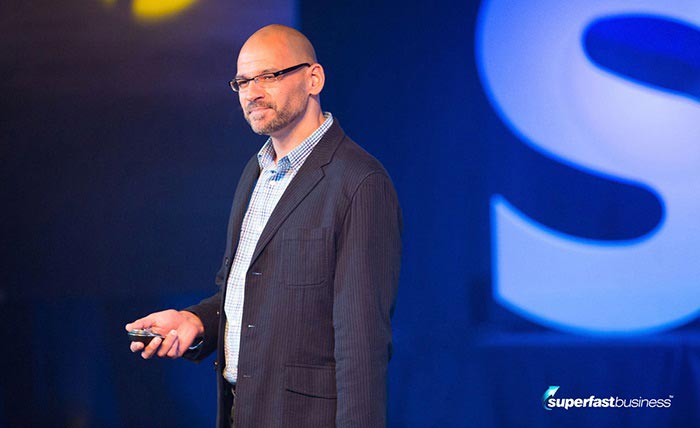
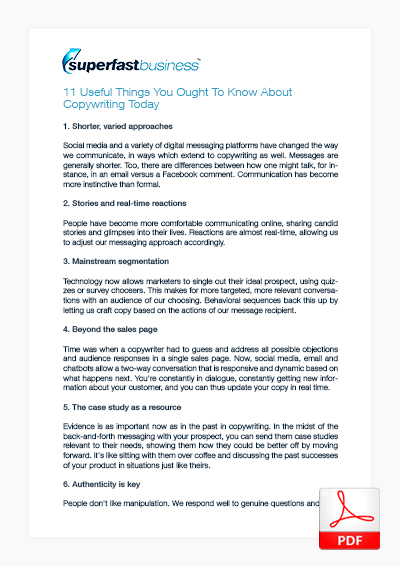










Leave a Reply